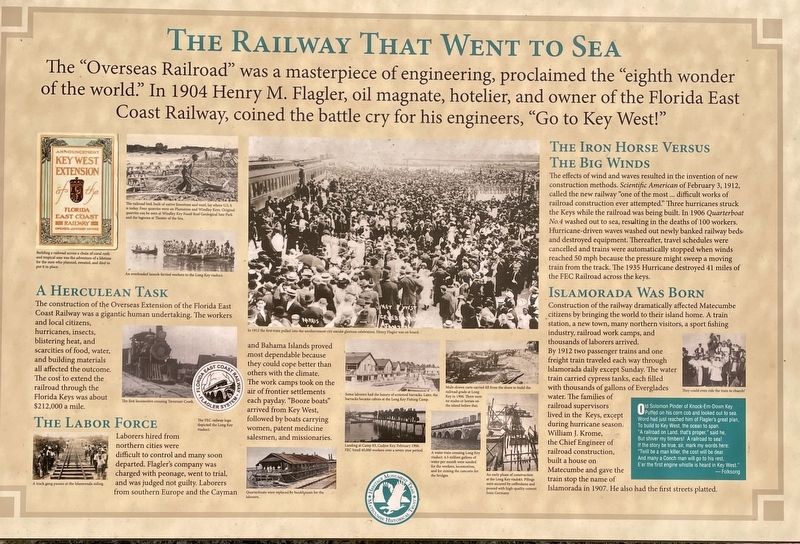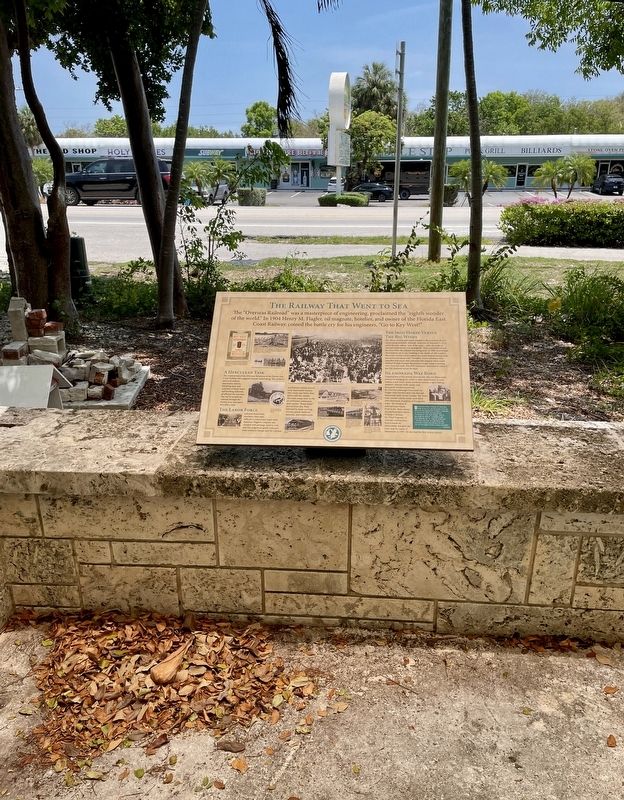Islamorada in Monroe County, Florida — The American South (South Atlantic)
The Railway That Went To Sea
— Heritage Monument Trail, Matacumbe Historical Trust —
The "Overseas Railroad" was a masterpiece of engineering, proclaimed the "eighth wonder of the world." In 1904 Henry M. Flagler, oil magnate, hotelier, and owner of the Florida East Coast Railway, coined the battle cry for his engineers, "Go to Key West!"
A Herculean Task
The construction of the Overseas Extension of the Florida East Coast Railway was a gigantic human undertaking. The workers and local citizens, hurricanes, insects, blistering heat, and scarcities of food, water, and building materials all affected the outcome. The cost to extend the railroad through the Florida Keys was about $212,000 a mile.
A Labor Force
Laborers hired from northern cities were difficult to control and many soon departed. Flagler's company was charged with peonage, went to trial, and was judged not guilty. Laborers from southern Europe and the Cayman and Bahama Islands proved most dependable because they could cope better than others with the climate.
The work camps took on the air of frontier settlements each payday. "Booze boats" arrived from Key West, followed by boats carrying women, patent medicine salesmen, and missionaries.
The Iron Horse Versus The Big Winds
The effects of wind and waves resulted in the invention of new construction methods. Scientific American of February 3, 1912, called the new railway "one of the most ... difficult works of railroad construction ever attempted." Three hurricanes struck the Keys while the railroad was being built. In 1906 Quarterboat No.4 washed out to sea, resulting in the deaths of 100 workers. Hurricane-driven waves washed out newly banked railway beds and destroyed equipment. Thereafter, travel schedules were cancelled and trains were automatically stopped when winds reached 50 mph because the pressure might sweep a moving train from the track. The 1935 Hurricane destroyed 41 miles of the FEC Railroad across the keys.
Islamorada Was Born
Construction of the railway dramatically affected Matecumbe citizens by bringing the world to their island home. A train station, a new town, many northern visitors, a sport fishing industry, railroad work camps, and thousands of laborers arrived. By 1912 two passenger trains and one freight train traveled each way through Islamorada daily except Sunday. The water train carried cypress tanks, each filled with thousands of gallons of Everglades water. The families of railroad supervisors lived in the Keys, except during hurricane season. William J. Krome, the Chief Engineer of railroad construction, built a house on Matecumbe and gave the train stop the name of Islamorada in 1907. He also had the first streets platted.
(sidebar)
Old Solomon Pinder of Knock-Em-Down Key puffed on his com cob and looked out to sea. Word had just reached him of Flagler's great plan, to build to Key West, the ocean to span. “A railroad on Land, that's proper,” said he. But shiver my timbers! A railroad to sea! If the story be true, sir, mark my words here: “Twill be a man killer, the cost will be dear. And many a Conch man will go to his rest, E'er the first engine whistle is heard in Key West."
—Folksong
(captions)
Building a railroad across a chain of coral reefs and tropical seas was the adventure of a lifetime for the men who planned, sweated, and died to put it in place.
A track gang passes at the Islamorada siding.
The railroad bed, built of native limestone and marl, lay where U.S.1 is today. Four quarries were on Plantation and Windley Keys. Original quarries can be seen at Windley Key Fossil Reef Geological State Park and the lagoons at Theater of the Sea.
An overloaded launch ferried workers to the Long Key viaduct.
The FEC railway logo depicted the Long Key viaduct.
In 1912 the first train pulled into the southernmost city amidst glorious celebration. Henry Flagler was on board.
Some laborers had the luxury of screened barracks. Later, the barracks became cabins at the Long Key Fishing Camp.
Landing at Camp 83, Cudjoe Key, February 1906. FEC hired 40,000 workers over a seven-year period.
Mule-drawn carts carried fill from the shore to build the railroad grade at Long Key in 1906. There were no mules or horses on the island before that.
A water train crossing Long Key viaduct. 4.5 million gallons of water were needed for the workers, locomotives, and for mixing the concrete for the bridges.
An early phase of construction at the Long Key viaduct. Pilings were secured by cofferdams and poured with high-quality cement from Germany.
They could even ride the train to church!
Erected by Heritage Monument Trail, Matacumbe Historical Trust.
Topics. This historical marker is listed in these topic lists: Bridges & Viaducts • Disasters • Industry & Commerce • Railroads & Streetcars • Waterways & Vessels. A significant historical year for this entry is 1904.
Location. 24° 55.572′ N, 80° 37.585′ W. Marker is in Islamorada, Florida, in Monroe County. Marker can be reached from Overseas Highway (U.S. 1) north of North Ocean Lane, on the left when traveling north. Touch for map. Marker is at or near this postal address: 82616 Overseas Highway, Islamorada FL 33036, United States of America. Touch for directions.
Other nearby markers. At least 8 other markers are within walking distance of this marker. The Florida Keys Memorial (here, next to this marker); Native Americans (here, next to this marker); Geological History of the Florida Keys (here, next to this marker); The Early Settlers of Upper Matecumbe Key (a few steps from this marker); The Spanish Treasure Fleets (a few steps from this marker); The Storm that Still Howls (a few steps from this marker); Site of Islamorada Railway Station (approx. 0.3 miles away); The 1935 Hurricane (approx. 0.9 miles away). Touch for a list and map of all markers in Islamorada.
Also see . . .
1. 1935- Labor Day Hurricane. (Submitted on May 29, 2023, by Brandon D Cross of Flagler Beach, Florida.)
2. Heritage Monument Trail, Matacumbe Historical Trust. (Submitted on May 29, 2023, by Brandon D Cross of Flagler Beach, Florida.)
Credits. This page was last revised on June 7, 2023. It was originally submitted on May 29, 2023, by Brandon D Cross of Flagler Beach, Florida. This page has been viewed 75 times since then and 25 times this year. Photos: 1, 2. submitted on May 29, 2023, by Brandon D Cross of Flagler Beach, Florida. • Bernard Fisher was the editor who published this page.

